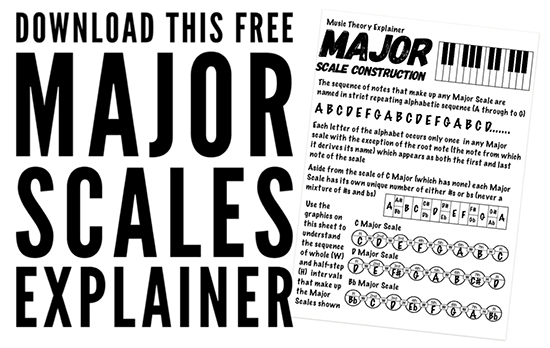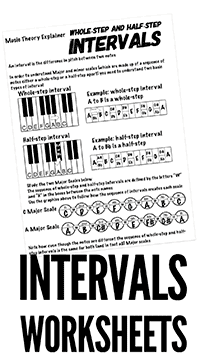Major and minor scales worksheets
When are students of Music Theory ready to "really" understand major scales?
Before developing a robust understanding of scales and how they work our students must first be familiar with a method of note naming and with the principles behind whole-step and half-step intervals please take a few moments to look at it
If students dont have a solid grounding in how notes are named and how whole and half step intervals work then music theory will probably (wrongly) be something that they give up doing because it will seem too difficult to them
Look! I don't know you and you don't know me and bearing in mind that what I'm really up to is trying to part you from some of your hard earned money but please do me a favour?
If you have landed on this page without first going to the page on intervals then take some time to stop by it
"Whole and Half-Step Intervals are the Cinderella of Music Theory"
I mention on that page that it is the least visited of my "main" pages and I think that this is because intervals (the "gaps" between notes) are a notional concept in that they only exist in relation to the notes that surround them
if our students end up feeling as vague about them as the music teachers who come to my site (as evidenced by the page view stats) then they really are in trouble and music theory will seem much harder than it needs to be
"If they can count to twelve and know the alphabet from A to G then our students already have the tools available to them to understand the harmonic and melodic content of all Western Music
"Music Theory Is Simple (but it is not neccesarily easy)!
I like to tell my students that
What makes it "easy" for our students is that they develop a very strong and secure skill set with regard to naming notes and assigning the correct name (or choice of names) to notes an interval of a whole or a half step from the note that they originally identified
That is what our worksheets dealing with the two basic and most vital/useful intervals are all about and please think about visiting that page (where you can pick up a whole bunch of free resources as an incentive)
Constructing Scales
Presuming that the folks we teach are familiar with the first two steps towards developing a thorough understanding of music theory then we are ready to look at constructing Major and minor scales

Music theory learning packs 5-7 deal with the concept of being able to construct any Major or minor scale from any given starting note
If you are familiar with the formal graded examinations offerd by exam boards this may seem like a rediculously advanced concept for a novice because those in the business of selling and dishing out qualifications choose to "drip feed" scales and keys as their grades progress Typically students studying at Grade 1 level tend to come across the scale of C Major (and possibly G Major?) before encountering scales containing more sharps or flats as the grades (and the time!) progress
This is a Con Trick!
As I said earlier....... "If our students can count to twelve and know their alphabet from A to G they can work out the notes in any Major or minor scale just so long as they can name notes correctly, identify the notes a whole or half step away from the one originally identified and know the scale spellings for Major and minor scales"
It is far better to have our students understand the scales that are the bedrock and the building blocks of just about all of the music that we play and hear from the earliest stage rather than having some organisation who exist to sell qualifications doing some (years long!) "dance of the seven veils" before a "big reveal" after what for some of them can be half a lifetime of study
Pack 5: Major Scale construction 1
A Major Scale "Explainer" and two worksheets that build upon the knowledge of note naming and a learner's understanding of intervals to create Major Scales

Pack 6: Major Scale Construction 2
Above is a detail taken from one of the worksheets from the pack
The explainer and two more worksheets designed to ensure that learners can construct any Major Scale
Download and print more than 400 PDF Music Worksheets and Handouts
to use year after year
for less than the cost of a
single Paper Based Textbook
$18.00

Pack 7: Minor Scale Construction
The minor scales "Explainer" and two worksheets looking at the (different) sequence of whole-step and half-step intervals that will allow our students to identify the notes in any minor scale
The difference between Major and minor scales

There Are Another 350 + PDFs In The Download
The Basic Music Theory Course is a very important part of the download but it is only a small part of the story!
There are loads of resources that do use notation as well as a bunch of guitar themed handouts and worksheets
Material covering Blues and Pentatonic scales, 7th chords and inversions We also provide material relating to popular song form
A simple to use"Must have Toolkit" for the modern music educator for less than the price of a single textbook
$18.00

It is the intention that students are introduced to these handouts after they have become familiar with naming notes correctly and also the principles underpinning intervals of a whole and a half step. Please feel free to distribute them to your students during the course of your music lessons or even to pin them onto your classroom wall as a source of reference

Let your students know how Major Scales work
The free document featured here is designed to communicate the "rules" of Major Scale construction to learners in terms of the sequence of whole-step and half-step intervals common to every Major Scale

Free Major Scale "Explainer"
Studying Major Scales with Worksheets
Scales should not be covered by students of music theory until they have developed a thorough understanding of note naming along with the existence of and difference between whole and half step intervals

Below is a detail from the Major and minor scale handout that you can get by clicking the text above. It illustrates the similarities and the differences between Major and minor scales (that the minor scale can be regarded as a Major Scale with lowered third, sixth and seventh notes)


Why Learn about Major Scales?
A sound knowledge of the construction of major scales is at the heart of the study of music theory and without this understanding our students will struggle to make any real "joined up" sense of the subject?
Our download features a huge range of worksheets with varying levels of graphic support (keyboard diagrams etc).
By using the resources offered in this simple download it becomes possible to take a student group from a position where they have no functional knowledge of scales and their construction to a suituation in which they are able communicate the notes (either verbally or in notated form) for any common scale.
By employing the same resources in a slightly different way during classroom sessions it becomes possible to simultaneously address the differing levels of capability and prior learning that exist within any student group.

Some learners can be busy constructing scales using worksheets containing graphics similar to the picture above in which the learner has been required to fill in the letter names in the lower part of each circle. These "early stages" worksheets feature keyboard diagrams and/or scale formulae whilst other more "advanced" students can be set to working on sheets requiring notation only with the theoretical knowledge being the responsibility of the learner?
This graduated series of worksheets is designed to challenge individual students at a level appropriate to the current stage of their musical development and to give our learners the confidence that they need to deal with this vital component of a well rounded knowledge of music theory.
Lets take a closer look at the whole subject of teaching scales and spelling scales.......

What Are Scales?
It might seem like a bit of a strange question but it is a very important one?
Scales can be defined as being "a set of sounds arranged in order of pitch" Dig a little deeper and you can add the fact that these pitches are composed from a "pre-determined combination of intervals" (gaps between notes) So... scales are "A set of sounds arranged in order of pitch composed of a predetermined sequence of intervals" Having then decided what scales are it is perhaps just as important is to establish what scales are not?
Scales are NOT MUSICAL NOTATION!
They are often written down in notated form but it is perfectly possible to develop a meaningful understanding of scales (and how to use them) without at this stage either writing them down on (or reading them from) a musical staff.
This is in no way to suggest that musical notation is without value and any meaningful study of how music works will probably involve notated music to a greater or lesser degree but it is worth speculating that in the early stages of understanding scales etc. it might be better not to teach them this new subject (scale construction) in a "foreign" language (notation).
It may be more effective to have our learners confident in the construction of (at least a few?) scales before introducing them to notated music?

Major Scale Worksheets In the Classroom

The image above shows a variety of our scale worksheets aimed at students with differing levels of understanding and capability. Some feature graphic assistance in the form of guitar necks or keyboard diagrams while others require learners to consider scale formula and key signatures etc. They are intended to introduce novice learners to the concept of scales and from there to help develop a more sophisticated understanding of scales and how they can be regarded and/or used
The text below sets out how an educator might make use of our handouts and worksheets during the course of a series of music theory lessons to take students from the point where they have no knowledge of scale construction through to a stage where they are able to notate major and minor scales and key signatures directly onto music manuscript paper with no reference to visual aids at all?
It is not the intention that the journey should be made in a single session and one of the strengths of the approach outlined is that students can develop familiarity with scales at different rates as their capabilities and potential dictates.
The ethos underpinning this material is firstly to develop an awareness of the theory that underpins the construction of scales and from this point the object is to "turn that awareness of the theory into a familiarity with it"
By the time they are familiar with the topics under study you can expect students to be able to tell you the notes of a scale without having to write anything down or without recourse to handouts with keyboards/scale formulas on them.
Quite an ambitious target so where do we start?........
A First Music Theory Lesson

Distribute the handout shown ("notes on the keyboard") which names the notes with relation to their location on a piano keyboard. It is a good idea at this stage to ensure that all students become familiar with the idea that the white (natural) notes can be identified by a single letter name whereas the black keys are more ambiguous in that they can be assigned one of two letter names depending upon the circumstances in which they are being used.
Although simple this handout is a very important one because if you are able to constantly refer students back to it you can often find out the root of any problems that they are experiencing with music theory.
Whole and Half Steps (or tones and semitones)
After you have distributed the handouts make students aware of the two different kinds of "intervals" involved in the construction of any Major (and for that matter minor?) scales
Explain to the group that a half step (also known as a semitone) is a movement of a single chromatic step from any given given starting note (for example from the white note of C up to the black note which is labelled C# or Db.
When this has been established introduce them to the idea of a whole step (alternately known as a tone) being two chromatic steps (from C up to D or from Bb down to Ab etc.)
When your students are comfortable with this idea it is a good idea to mention the "rules" of major (and for that matter minor) scale construction?
Major Scale Construction: "The Rules"
Rule no 1
The names of the notes of a major or minor scale follow the strict alphabetic sequence (if the first note of a scale is an A then it follows that the second will be a B note, the third a C note and so on)
Rule no 2
The only letter of the alphabet to appear twice within a scale is the first (or "root") note which "bookends" the scale by featuring at the beginning and the end of it.
Rule no 3
You should not mix #'s and b's within a scale
Establishing The Sequence of Whole and Half Steps in any Major Scale
Make students aware of the fact that all major scales follow the same sequence of intervals (whole steps and half steps) and that this sequence, once learned on a single scale can then be transferred to all others.
Stress to your music students that if they are able to understand the construction of a C Major Scale then they have the tools to understand the construction of any Major scale as the sequence of intervals is exactly the same?
Major Scales:The sequence of musical intervals
Thinking in terms of whole (W) and half (H) steps that sequence is W-W-H-W-W-W-H (or alternately tone-tone-senitone-tone-tone tone-semitone)
If this were a phone number it could be remembered as
221 2221
or perhaps more easily"double two one-treble two one"?
Now might be a good time to distribute the handout featuring the C Major scale on a keyboard?
Talk your students through the handout (or the free powerpoint demonstration that you can download now if you click this text?) pointing out the sequence of intervals and how it corresponds to the
"W-W-H-W-W-W-H"
formulae discussed earlier.

Having analysed the construction of a single major scale now is a good time to introduce the idea that "if you can create a single major scale then you can create them all?" and that you don't have to have the first clue about musical notation in order to understand scales completely?
By using the sequence of whole and half steps outlined above and by applying a couple of simple rules you can understand how the C major scale is constructed. From this point it is possible to use the same process to work out which notes are in any Major Scale?
From this point in the programme (in future lessons?) more "advanced" handouts can be incorporated which are concerned with developing an understanding of other scales and musical notation.
We have produced a series of lesson plans (arranged into topics) that might give a more developed view as to how you might use our materials to make your teaching less stressful. We also have pages on this site dealing with topics such as chord construction and the existence of harmonic concepts such as the diatonic system etc.
As members of your student group become firstly "aware of" and then "familiar with" the fomulae and principles invilved in the construction of major and minor scales it is possible to present them with a series of worksheets which "scale down" the amount of graphic assistance on offer (there are handouts without either the scale formulae or the keyboard diagrams etc) until they feel comfortable in a situation in which they are able to write down or verbally articulate any major or minor scale purely from memory demonstrating an ability to provide either the required accidentals or key signature.
$18.00
DOWNLOAD
the Music Teacher's Resources Now?
400 individual PDF files with loads more than Major and Minor Scales in there?
Buy your music teaching resources in complete safety via any major credit card (through paypal) or directly through your paypal account if you have one. If you choose to use a credit card, rest assured that we never see your credit card details as paypal do all of that for us.
When Paypal receive your payment you will be immediately invited to click a
"RETURN TO SELLER"button.
Press the button and you will be taken to a page from where you can download the products that you have paid for NOW!
In the (rare) event that something should go wrong with the order/download process just email me at robh@teachwombat.com
I will check the order and send you the links that will get you to your stuff.
Cheers! Rob!

















